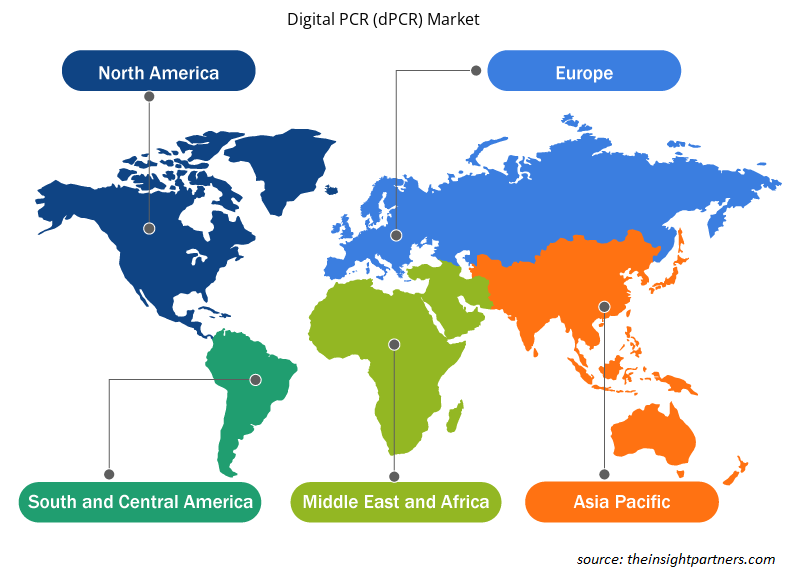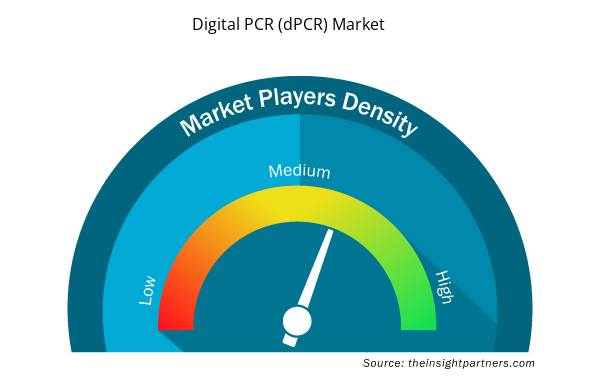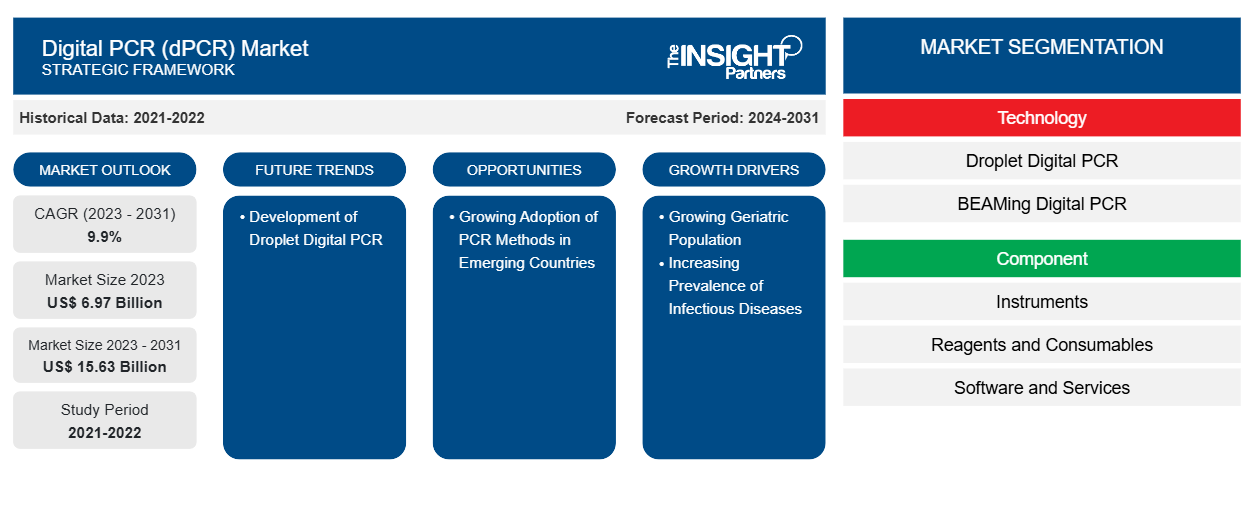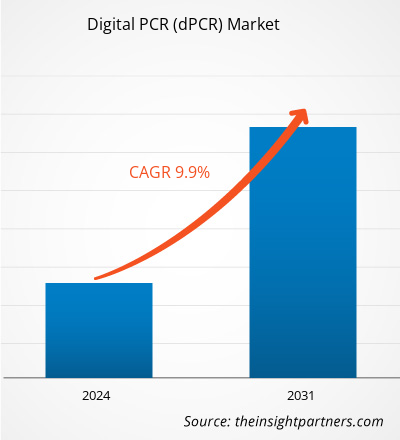Si prevede che il mercato della PCR digitale (dPCR) raggiungerà i 15,63 miliardi di dollari entro il 2031, rispetto ai 6,97 miliardi di dollari del 2023; si stima che il mercato registrerà un CAGR del 9,9% nel periodo 2023-2031.
dPCR è una tecnologia rivoluzionaria che offre una quantificazione ultrasensibile e assoluta degli acidi nucleici. È una delle tecniche più accurate, precise e sensibili per la rilevazione di sequenze specifiche di acidi nucleici. È diventato uno strumento cruciale e affidabile per l'analisi molecolare. L'aumento dell'incidenza di malattie genetiche e infettive che possono essere diagnosticate e curate utilizzando tecniche dPCR supporta la crescita del mercato della PCR digitale (dPCR) . Le tendenze del mercato della PCR digitale (dPCR) includono progressi tecnologici che aiutano la quantificazione ad alta precisione e assoluta delle molecole di DNA target, consentendo così un'ampia gamma di applicazioni nella diagnosi e nella ricerca.
Fattori di crescita:
La sintesi genica è lo strumento più accettato nel campo della tecnologia del DNA ricombinante. Nella sintesi genica, l'espressione proteica ricombinante e la tecnologia dPCR vengono utilizzate per scopi di amplificazione e quantificazione. Nel 2021, Camena Bioscience, una startup di biologia sintetica che fornisce geni alle industrie biotecnologiche e farmaceutiche, ha completato un round di finanziamento di serie A da 10 milioni di dollari guidato da Mercia. Con i fondi aggiuntivi, la società prevede di espandere le sue operazioni e alimentare i suoi sforzi di sviluppo di gSynth, la sua innovativa piattaforma di sintesi del DNA. La piattaforma tecnologica e altre risorse correlate aiutano la società ad accelerare lo sviluppo della sintesi genica.
Nel 2020, EVONETIX LTD, una startup di biologia sintetica che sta creando una piattaforma desktop per la sintesi genica ad alta fedeltà, rapida e scalabile, ha annunciato il completamento del suo round di finanziamento di serie B. La società, guidata da Foresite Capital (un nuovo investitore), ha raccolto 30 milioni di dollari (23 milioni di sterline) in questo round. Pertanto, i crescenti investimenti delle aziende alimentano la crescita del mercato della sintesi genica, contribuendo così alla crescita del mercato della PCR digitale (dPCR).
Personalizza questo report in base alle tue esigenze
Riceverai la personalizzazione gratuita di qualsiasi report, comprese parti di questo report, o analisi a livello nazionale, pacchetto dati Excel, oltre a usufruire di grandi offerte e sconti per start-up e università
- Scopri le principali tendenze di mercato in questo rapporto.Questo campione GRATUITO includerà analisi di dati che spaziano dalle tendenze di mercato alle stime e alle previsioni.
Segmentazione e ambito del report:
L'analisi di mercato della PCR digitale (dPCR) è stata condotta considerando i seguenti segmenti: tecnologia, componente, applicazione, utente finale e geografia. In base alla tecnologia, il mercato è segmentato in PCR digitale a gocce (ddPCR) e PCR digitale BEAMing. In termini di componente, il mercato è classificato in strumenti, reagenti e materiali di consumo, software e servizi. In base all'applicazione, il mercato è classificato in clinico, di ricerca e forense. L'ambito geografico del rapporto di mercato della PCR digitale (dPCR) copre Nord America (Stati Uniti, Canada e Messico), Europa (Francia, Germania, Regno Unito, Spagna, Italia e resto d'Europa), Asia Pacifico (Cina, Giappone, India, Corea del Sud, Australia e resto dell'Asia Pacifico), Medio Oriente e Africa (Arabia Saudita, Sud Africa, Emirati Arabi Uniti e resto del Medio Oriente e Africa) e Sud e Centro America (Brasile, Argentina e resto del Sud e Centro America).
Analisi segmentale:
Il mercato della PCR digitale (dPCR), per prodotto, è categorizzato in PCR digitale a goccia (ddPCR) e PCR digitale BEAMing. Il segmento ddPCR ha detenuto una quota di mercato significativa nel 2023. Si prevede che registrerà il CAGR più elevato nel mercato nel periodo 2023-2031.
In base al componente, il mercato è categorizzato in strumenti, reagenti e materiali di consumo e indicazioni software e servizi. Il segmento reagenti e materiali di consumo ha detenuto una quota di mercato significativa nel 2023 e si stima che registrerà il CAGR più elevato nel periodo 2023-2031.
In base all'applicazione, il mercato è segmentato in clinico, di ricerca e forense. Il segmento clinico ha detenuto una quota di mercato significativa per la PCR digitale (dPCR) nel 2023; si prevede che registrerà il CAGR più elevato nel periodo 2023-2031.
In base all'utente finale, il mercato è segmentato in ospedali e centri diagnostici, aziende farmaceutiche e biotecnologiche, laboratori di ricerca e istituti accademici, laboratori forensi e organizzazioni di ricerca clinica. Il segmento ospedali e centri diagnostici ha detenuto una quota di mercato significativa della PCR digitale (dPCR) nel 2023; si prevede che registrerà il CAGR più elevato nel periodo 2023-2031.
Analisi regionale:
In termini geografici, il mercato della PCR digitale (dPCR) è segmentato in Nord America, Europa, Asia Pacifico, America meridionale e centrale e Medio Oriente e Africa. Nel 2023, il Nord America ha conquistato una quota significativa del mercato. Nel 2023, gli Stati Uniti hanno dominato il mercato in questa regione. La crescita del mercato della PCR digitale (dPCR) in Nord America è attribuita a conferenze scientifiche, workshop ed eventi condotti negli Stati Uniti e in Canada, che aiutano i partecipanti provenienti da diverse parti del mondo a scambiarsi tendenze e gli ultimi risultati della ricerca basati sulla PCR. Ad esempio, Global Engage della Global Information Incorporation ha condotto un summit di due giorni con il contributo di scienziati di tutto il mondo sulle strategie e lo sviluppo della dPCR, nonché la discussione di casi di studio che coinvolgono il contributo della dPCR nell'assistenza sanitaria. Il coinvolgimento attivo del paese è anche uno dei fattori trainanti che portano alla crescita della regione nel mercato globale della PCR digitale (dPCR) nella regione.
Sviluppi del settore e opportunità future:
Il rapporto di mercato Digital PCR (dPCR) include il posizionamento e la concentrazione aziendale per valutare le prestazioni dei concorrenti nel mercato. Secondo i comunicati stampa aziendali, di seguito sono menzionate alcune iniziative intraprese dai principali attori che operano nel mercato:
- A luglio 2023, Bio-Rad Laboratories, Inc. ha lanciato il suo primo test dPCR multiplex ultrasensibile, il ddPLEX ESR1 Mutation Detection Kit. Con il lancio di questo prodotto, l'azienda prevede di estendere la disponibilità della sua offerta ddPCR per il mercato oncologico, dove i test di rilevamento delle mutazioni multiplex e altamente sensibili aiutano la ricerca traslazionale, la selezione della terapia e il monitoraggio delle malattie.
- Nel giugno 2021, Bio-Rad Laboratories Inc. ha introdotto il "Prevalence ddPCR SARS-CoV-2 Wastewater Quantification Kit", uno strumento sensibile, conveniente e accurato per rilevare SARS-CoV-2 nelle acque reflue della comunità.
- I Centri per il controllo e la prevenzione delle malattie (CDC) raccomandano la tecnica ddPCR per l'analisi delle acque reflue e l'Agenzia per la protezione dell'ambiente (EPA) ha pubblicato questa tecnologia come un metodo affidabile per quantificare i virus nelle acque reflue.
Approfondimenti regionali sul mercato del PCR digitale (dPCR)
Le tendenze regionali e i fattori che influenzano il mercato Digital PCR (dPCR) durante il periodo di previsione sono stati ampiamente spiegati dagli analisti di Insight Partners. Questa sezione discute anche i segmenti di mercato Digital PCR (dPCR) e la geografia in Nord America, Europa, Asia Pacifico, Medio Oriente e Africa e Sud e Centro America.

- Ottieni i dati specifici regionali per il mercato PCR digitale (dPCR)
Ambito del rapporto di mercato PCR digitale (dPCR)
| Attributo del report | Dettagli |
|---|---|
| Dimensioni del mercato nel 2023 | 6,97 miliardi di dollari USA |
| Dimensioni del mercato entro il 2031 | 15,63 miliardi di dollari USA |
| CAGR globale (2023-2031) | 9,9% |
| Dati storici | 2021-2022 |
| Periodo di previsione | 2024-2031 |
| Segmenti coperti | Per tecnologia
|
| Regioni e Paesi coperti | America del Nord
|
| Leader di mercato e profili aziendali chiave |
|
Densità degli attori del mercato del PCR digitale (dPCR): comprendere il suo impatto sulle dinamiche aziendali
Il mercato del Digital PCR (dPCR) sta crescendo rapidamente, spinto dalla crescente domanda degli utenti finali dovuta a fattori quali l'evoluzione delle preferenze dei consumatori, i progressi tecnologici e una maggiore consapevolezza dei vantaggi del prodotto. Con l'aumento della domanda, le aziende stanno ampliando le loro offerte, innovando per soddisfare le esigenze dei consumatori e capitalizzando sulle tendenze emergenti, il che alimenta ulteriormente la crescita del mercato.
La densità degli operatori di mercato si riferisce alla distribuzione di aziende o società che operano in un particolare mercato o settore. Indica quanti concorrenti (operatori di mercato) sono presenti in un dato spazio di mercato in relazione alle sue dimensioni o al valore di mercato totale.
Le principali aziende che operano nel mercato del PCR digitale (dPCR) sono:
- Thermo Fisher Scientific, Inc.
- Società anonima F. Hoffmann-la Roche Ltd.
- QIAGEN
- Akara bio, Inc.
- Agilent Technologies, Inc.
Disclaimer : le aziende elencate sopra non sono classificate secondo un ordine particolare.

- Ottieni una panoramica dei principali attori del mercato del PCR digitale (dPCR)
Scenario competitivo e aziende chiave:
Le previsioni di mercato della PCR digitale (dPCR) possono aiutare gli stakeholder a pianificare le loro strategie di crescita. Thermo Fisher Scientific, Inc.; F. Hoffmann-la Roche Ltd.; QIAGEN; Akara bio, Inc.; Agilent Technologies, Inc.; Biomerieux SA; Abbott Laboratories; Merck KgaA; Promega Corporation; e BD sono tra i principali attori profilati nel mercato. Queste aziende si concentrano sull'introduzione di nuovi prodotti ad alta tecnologia, sui progressi nei prodotti esistenti e sulle espansioni geografiche per soddisfare la crescente domanda dei consumatori in tutto il mondo.
- Analisi storica (2 anni), anno base, previsione (7 anni) con CAGR
- Analisi PEST e SWOT
- Valore/volume delle dimensioni del mercato - Globale, regionale, nazionale
- Industria e panorama competitivo
- Set di dati Excel



Report Coverage
Revenue forecast, Company Analysis, Industry landscape, Growth factors, and Trends

Segment Covered
This text is related
to segments covered.

Regional Scope
North America, Europe, Asia Pacific, Middle East & Africa, South & Central America

Country Scope
This text is related
to country scope.
Domande frequenti
dPCR is a new technique utilized for DNA amplification and quantification that uses molecular counting protocol. dPCR is usually used to distinguish the expression of alleles, track viral infection to individual bacterial cells, quantify cancer genes, and detect fetal DNA in circulating blood.
The Digital PCR (dPCR) market is expected to be valued at US$ 15.63 billion by 2031.
The global Digital PCR (dPCR) market is segmented based on technology, component, application, and end user. The Digital PCR (dPCR) market, by component, is categorized into instruments, reagents and consumables, and software and services. The reagents and consumables segment held a significant market share in 2023 and is anticipated to record the highest CAGR in the market during 2023–2031.
The factors driving the growth of the Digital PCR (dPCR) market include the rising incidence of infectious diseases and technological advancements in PCR technologies. However, the high costs of PCR systems, hampers the growth of the Digital PCR (dPCR) market.
The Digital PCR (dPCR) market was valued at US$ 6.97 billion in 2023.
The Digital PCR (dPCR) market majorly consists of the players, including Thermo Fisher Scientific, Inc.; F. Hoffmann-la Roche Ltd.; QIAGEN; Akara bio, Inc.; Agilent Technologies, Inc.; Biomerieux SA; Abbott Laboratories; Merck KgaA; Promega Corporation; and BD.
Trends and growth analysis reports related to Life Sciences : READ MORE..
The List of Companies - Digital PCR (dPCR) Market
- Thermo Fisher Scientific, Inc.
- F. Hoffmann-la Roche Ltd
- QIAGEN
- Akara bio, Inc.
- Agilent Technologies, Inc.
- Biomerieux SA
- Abbott Laboratories
- Merck KgaA
- Promega Corporation
- BD.
The Insight Partners performs research in 4 major stages: Data Collection & Secondary Research, Primary Research, Data Analysis and Data Triangulation & Final Review.
- Data Collection and Secondary Research:
As a market research and consulting firm operating from a decade, we have published and advised several client across the globe. First step for any study will start with an assessment of currently available data and insights from existing reports. Further, historical and current market information is collected from Investor Presentations, Annual Reports, SEC Filings, etc., and other information related to company’s performance and market positioning are gathered from Paid Databases (Factiva, Hoovers, and Reuters) and various other publications available in public domain.
Several associations trade associates, technical forums, institutes, societies and organization are accessed to gain technical as well as market related insights through their publications such as research papers, blogs and press releases related to the studies are referred to get cues about the market. Further, white papers, journals, magazines, and other news articles published in last 3 years are scrutinized and analyzed to understand the current market trends.
- Primary Research:
The primarily interview analysis comprise of data obtained from industry participants interview and answers to survey questions gathered by in-house primary team.
For primary research, interviews are conducted with industry experts/CEOs/Marketing Managers/VPs/Subject Matter Experts from both demand and supply side to get a 360-degree view of the market. The primary team conducts several interviews based on the complexity of the markets to understand the various market trends and dynamics which makes research more credible and precise.
A typical research interview fulfils the following functions:
- Provides first-hand information on the market size, market trends, growth trends, competitive landscape, and outlook
- Validates and strengthens in-house secondary research findings
- Develops the analysis team’s expertise and market understanding
Primary research involves email interactions and telephone interviews for each market, category, segment, and sub-segment across geographies. The participants who typically take part in such a process include, but are not limited to:
- Industry participants: VPs, business development managers, market intelligence managers and national sales managers
- Outside experts: Valuation experts, research analysts and key opinion leaders specializing in the electronics and semiconductor industry.
Below is the breakup of our primary respondents by company, designation, and region:

Once we receive the confirmation from primary research sources or primary respondents, we finalize the base year market estimation and forecast the data as per the macroeconomic and microeconomic factors assessed during data collection.
- Data Analysis:
Once data is validated through both secondary as well as primary respondents, we finalize the market estimations by hypothesis formulation and factor analysis at regional and country level.
- Macro-Economic Factor Analysis:
We analyse macroeconomic indicators such the gross domestic product (GDP), increase in the demand for goods and services across industries, technological advancement, regional economic growth, governmental policies, the influence of COVID-19, PEST analysis, and other aspects. This analysis aids in setting benchmarks for various nations/regions and approximating market splits. Additionally, the general trend of the aforementioned components aid in determining the market's development possibilities.
- Country Level Data:
Various factors that are especially aligned to the country are taken into account to determine the market size for a certain area and country, including the presence of vendors, such as headquarters and offices, the country's GDP, demand patterns, and industry growth. To comprehend the market dynamics for the nation, a number of growth variables, inhibitors, application areas, and current market trends are researched. The aforementioned elements aid in determining the country's overall market's growth potential.
- Company Profile:
The “Table of Contents” is formulated by listing and analyzing more than 25 - 30 companies operating in the market ecosystem across geographies. However, we profile only 10 companies as a standard practice in our syndicate reports. These 10 companies comprise leading, emerging, and regional players. Nonetheless, our analysis is not restricted to the 10 listed companies, we also analyze other companies present in the market to develop a holistic view and understand the prevailing trends. The “Company Profiles” section in the report covers key facts, business description, products & services, financial information, SWOT analysis, and key developments. The financial information presented is extracted from the annual reports and official documents of the publicly listed companies. Upon collecting the information for the sections of respective companies, we verify them via various primary sources and then compile the data in respective company profiles. The company level information helps us in deriving the base number as well as in forecasting the market size.
- Developing Base Number:
Aggregation of sales statistics (2020-2022) and macro-economic factor, and other secondary and primary research insights are utilized to arrive at base number and related market shares for 2022. The data gaps are identified in this step and relevant market data is analyzed, collected from paid primary interviews or databases. On finalizing the base year market size, forecasts are developed on the basis of macro-economic, industry and market growth factors and company level analysis.
- Data Triangulation and Final Review:
The market findings and base year market size calculations are validated from supply as well as demand side. Demand side validations are based on macro-economic factor analysis and benchmarks for respective regions and countries. In case of supply side validations, revenues of major companies are estimated (in case not available) based on industry benchmark, approximate number of employees, product portfolio, and primary interviews revenues are gathered. Further revenue from target product/service segment is assessed to avoid overshooting of market statistics. In case of heavy deviations between supply and demand side values, all thes steps are repeated to achieve synchronization.
We follow an iterative model, wherein we share our research findings with Subject Matter Experts (SME’s) and Key Opinion Leaders (KOLs) until consensus view of the market is not formulated – this model negates any drastic deviation in the opinions of experts. Only validated and universally acceptable research findings are quoted in our reports.
We have important check points that we use to validate our research findings – which we call – data triangulation, where we validate the information, we generate from secondary sources with primary interviews and then we re-validate with our internal data bases and Subject matter experts. This comprehensive model enables us to deliver high quality, reliable data in shortest possible time.


 Ottieni un campione gratuito per questo repot
Ottieni un campione gratuito per questo repot